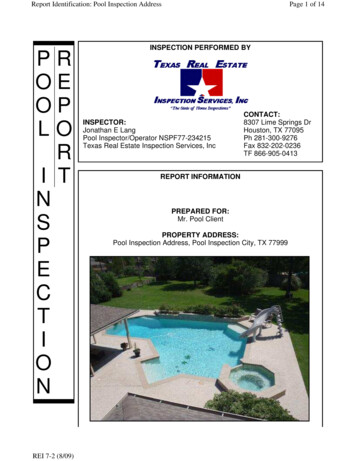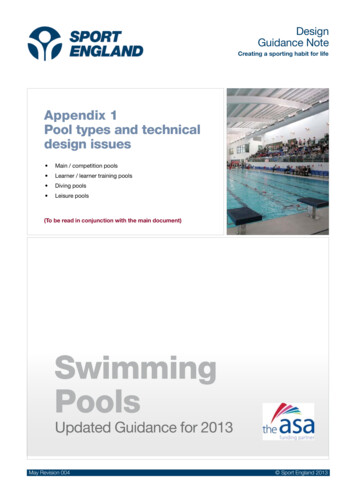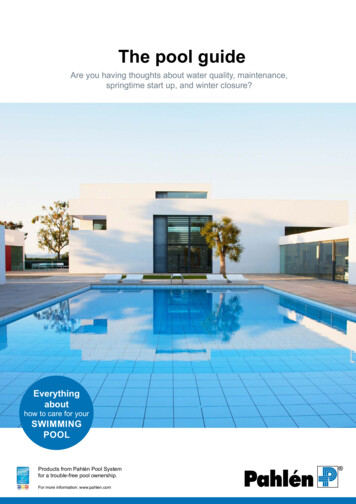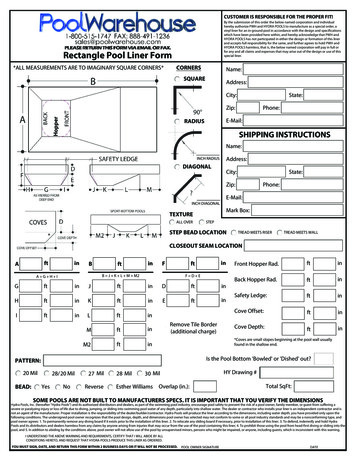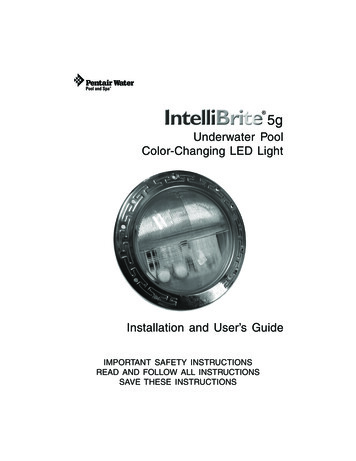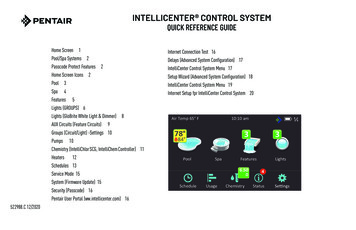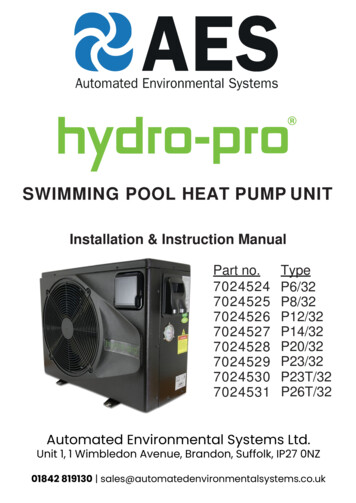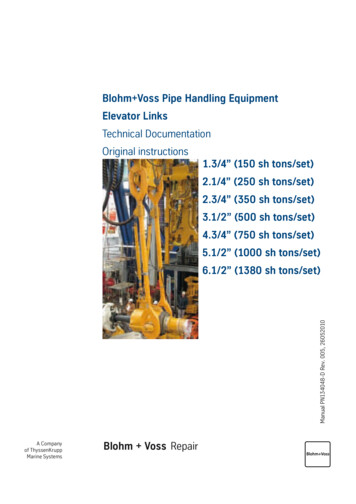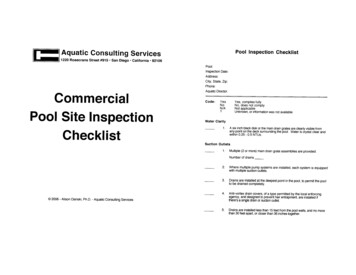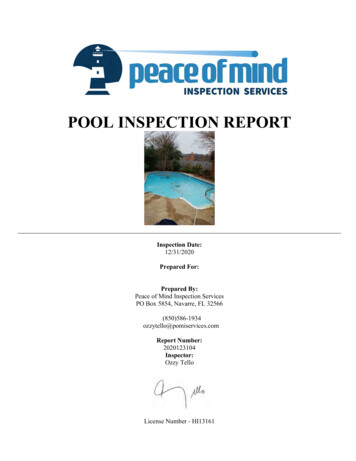
Transcription
POOL INSPECTION REPORTInspection Date:12/31/2020Prepared For:Prepared By:Peace of Mind Inspection ServicesPO Box 5854, Navarre, FL 32566(850)586-1934ozzytello@pomiservices.comReport Number:2020123104Inspector:Ozzy TelloLicense Number - HI13161
RECOMMENDED MAINTENANCE SCHEDULE All of the valves should be fully open.Brush the pool walls and bottom once a week.Check hardness, TDS (Total Dissolved Solids), and total alkalinity once a month.Check the pH twice a week.Check the pump strainer pot once a week.Check the skimmer basket twice a week.Check the water level once a day.Clean the solar panels once a month (if applicable)Clean the waterline once a week.Empty and clean the filter every three months.Look for leaks every day.Test for metals once every six months.The heater should be on and activated. The gas shut-off valve should be open. The switch should be on.Check for a pilot light, ignition, or flame at the fuel-fired heater. Check the level in the propane storagetank (if applicable)The skimmer and main drain should be clear of blockages and debris. Skimmers require cleaning.The strainer pot at the pump should be cleaned routinely.The thermostat should be connected, active, and set properly (if applicable)There has to be enough water in the pool or spa. Check the level of the water.There might be an imbalance of the water chemistry, causing scaling. Check for scale-causing cloggingor restriction of water flow.There shouldn’t be any trapped air in the system. Air at the filter tank should be purged routinely.There shouldn’t be any water leaks at the plumbing connections or equipment.Vacuum the pool once or twice a week.Winterize once a year.
DescriptionTasks The type of swimming pool (or spa). Comments: Concrete Above Ground Fiberglass Inground Vinyl Liner Recommendation: Inquire from the seller/homeowner the age of the vinyl liner. Generally speaking,inground pool vinyl liners last 5 – 9 years. Additional Notes: The sprinkler system equipment is installed next to the pool equipment. Sprinklersystems are out of scope and was not part of these inspections. Although, exposed wires were noted.Recommend that when the electrician is called to address home issues, they can also look over thesprinkler pump system.
DeckTasks Coping stones and tiles are not chipped, cracked or loose. Condition:Satisfactory Decks around pool are not cluttered. Condition:Satisfactory Decks on all sides of the pool meet minimum safety standards. Condition:Satisfactory Surfaces leading to the pool, including the deck and steps, are slip-resistant. Condition:Marginal Comments: Only concrete deck present.
The deck is separated from the pool wall perimeter. Condition: Yes No There are standing puddles on the deck. Condition: Yes No
ElectricalTasks All 125-volt receptacles that are rated 30-ampere or less and located within 20’ of the inside walls of thepool, outdoor spa or hot tub shall be protected by a GFCI, ground-fault circuit-interrupter. Condition:Poor Comments: No receptacles noted within 20’ of the pool. At least one 125-volt, 15- or 20-ampere receptacle is required to be installed. It should be located at least 6’(and not farther than 20 feet) from the inside wall of a pool, or outdoor spa or hot tub. This requiredreceptacle should not be higher than 6-1/2’ from the floor, platform or ground at the pool or spa. Condition:Poor Comments: No receptacles noted within 20’ of the pool. Bonding and grounding are visible. Condition:Marginal Comments: Grounding wire excessively exposed. Recommend that the wire receive better protection. Cords that supply electricity to swimming pool equipment must have a copper equipment groundingconductor not smaller than 12 AWG and shall be provided with a grounding-type attachment plug. Condition:Marginal Comments: Grounding wire is loosely “twist tied” and should be better secured.
Electrical wiring is not passing directly over the pool or spa. Condition:Satisfactory For indoor pools and spas, there are some exceptions to not having luminaires and paddle fans installedoverhead. Luminaires and paddle fans can be installed at least 12 feet above the water level without GFCIprotection. However, if GFCI protection is provided, enclosed luminaires and fans are permitted as close as7-1/2 feet above the water. Condition:N/A For outdoor pools and spas, luminaires and paddle fans are not permitted in the area over the water andextending 5’ horizontally from the inside edge of the pool to a distance of 12’ above the water level. Condition:N/A GFCIs are installed. Condition:Satisfactory If there is a separate panelboard supplying the swimming pool equipment and it is fed from the serviceequipment, it must have an insulated equipment grounding conductor of at least 12 AWG run with thefeeders from the service equipment. Condition:N/A Luminaires and related equipment should be grounded. All lighting assemblies and luminaires must beconnected to an insulated copper equipment grounding conductor not smaller than 12 AWG. Condition:Poor Comments: The light fixture would not turn on when the light switch was engaged, located in the masterbedroom. Suspect that the light bulb needs replacement. Only receptacles for specific equipment are permitted between 6 and 10’ from the inside walls of the pool,or outdoor spa or hot tub. They must be a single receptacle of the locking and grounding type so that aportable radio, for example, could not be plugged into it. The receptacle must also be GFCI-protected.There must not be any receptacles that supply power to appliances within 10’ of the inside wall of the poolor spa. All other receptacles must not be located within 6 feet of the inside walls of the pool, spa or hot tub.
Condition:Satisfactory Overhead conductors must be at least 22-1/2 feet away in any direction from the water level, edge of thewater surface, base of the diving platform, or permanently anchored raft. Condition:N/A The equipment grounding conductors should not be smaller than the supply conductors, and not smallerthan 16 AWG. Condition:Satisfactory The number of underwater lights is noted. Comments: One Two Three The top of the fixture lens of a luminaire must be at least 18” below the normal water level of a permanentpool, except where the luminaire is listed for use at other depths. Condition:Satisfactory The type, number and wattage of deck lighting are identified. Comments:Unknown There should be a means provided to simultaneously disconnect all ungrounded conductors for allequipment, except for lighting. Such means should be readily accessible and within sight of the equipmentand must be at least 5’ away from the inside walls of the pool, spa or hot tub. Condition:Poor Comments: None noted. There should be no switches (including timers or panelboards) within 5’ horizontally from the inside wallsof a pool, spa or hot tub except where separated from the pool, spa or hot tub by a permanent barrier, fenceor wall. This standard prevents bathers from reaching a device. Or the switches must be listed for usewithin 5’. Condition:Satisfactory Underground wiring should not be installed within 5’ from the inside walls of a pool or spa unless installedinside a corrosion-resistant conduit or raceway. Condition:Satisfactory
EquipmentTasks A clean sight glass or visual outfall of at least 3’ has been provided. Condition:Satisfactory Adequate clearances around the heater are maintained. Condition:N/A Air pressure-relief valves are installed on all pressure filter tanks. Condition:Satisfactory All ladders, stanchions, chairs, and rails have treads with a contrasting color coating or tile on both the topand vertical rise. Condition:Satisfactory All piping, filters and components that are part of the system are labeled, tagged, color-coded, orotherwise identified. Condition:Poor Comments: No labeling noted. Check valves between the heater and filter are installed. Condition:N/A During your inspection, check the lids or covers of the filter tanks. Lids on filter tanks might leak. The lidmight leak at the O-ring at the lid connection to the tank, or the leak might be at the relief-valve assemblyon top of the tank lid. Condition:Satisfactory
Electric radiant heaters should not be installed over a pool or within 5 feet horizontally from the insidewalls of the pool and should be at least 12’ away from the pool deck. Condition:N/A Filter tanks are accessible. Condition:Satisfactory Lights are installed and are operational. Condition:Poor Comments: Light bulb may need to be replaced. No physical damage is apparent at the pool equipment. Condition:Satisfactory Safety devices are installed on the heater. Condition:N/A Skimmer weirs, skimmer baskets, deck covers, and flow-adjustment devices are installed. Condition:Satisfactory The centrifugal pump is secured to its base and is operating quietly. The motor should be dry. The motor should be clean and free of debris. There should be no leaks. The strainer pot should be clean. The pump should not vibrate. There should be no unusual or unexpected noises. The pump should not be hot. Condition:Satisfactory The efficiency and BTU ratings of the heater are identified. Condition:N/A The filter’s brand is identified. Condition:Satisfactory Comments: Hayward Vari-Flo XL Valve The heater is installed downstream of the pump and filter. Condition:N/A The heater is installed on a level, non-combustible base. Condition:N/A The pressurized filter tanks and hair and lint traps are not leaking and are properly sealed. Condition:Satisfactory The thermostat is located and identified. Condition:N/A
The type of filtration system Comments: Cartridge The type of heater is identified. Condition:N/A Diatomaceous Earth (DE) Sand
General MaintenanceTasks All water quality and chemical levels were within acceptable ranges, based on visual inspection. Condition:Satisfactory Bacteriological water analysis is performed on a regular basis. Condition:Satisfactory Comments: Discussion with the seller/homeowner confirmed that a pool service company arrives weekly. Check the pool for plaster cracks, blisters, popped-off areas, and delamination. Some areas can be verysmall (about the size of a dime) to very big (about the size of a stop sign). These areas can be repaired. Ifthere are damaged areas bigger than that, then re-plastering may be required. The causes of delaminationmay likely be from an imbalance in the water, making the water aggressive enough to take calcium out ofthe plaster. When calcium is taken from the plaster, the plaster becomes weak and starts to separate ordelaminate. Condition:Marginal Comments: Previous repair noted of a possible ladder installed on the deep end of the pool. Hose bibs are installed near the pool. Condition:Satisfactory
It is recommended that the water temperature for a pool be set between 78 F to 82 F, and spas should beno hotter than 104 F. Comments: Pool inspection was performed during the winter months. Water temperature will be lowerthan optimal recommendations. No debris is visible. The water is clean. Condition:Marginal Comments: Excessive leaves found.
No unpleasant odors or irritating fumes are apparent. Condition:Satisfactory The pool is covered when not in use. Condition:N/A The pool shell appears smooth, without readily visible defects. Condition:Marginal Comments: After a discussion with the seller/homeowner, he described a time when the robot poolvacuum had damaged the bottom of the pool in a few spots. After further investigation, two noticeablepatches are noted in the bottom of the pool. Recommend that an inquiry is made to the seller/homeownerin regard to the age of the pool liner. Recommend that a quote from a pool liner vendor be obtained.
The pool water is tested at the frequency required or desired. Condition:Satisfactory The water level appears at the proper height to allow continuous overflow of water into the gutters orskimmers. Condition:Satisfactory Comments: During the general home inspection, the seller/homeowner arrived during the last hour toservice the pool and add water. Evidence of the hose noted on the pool deck. I inquired of theseller/homeowner on his reason for filling the pool with water and he responded that he performs this ritualevery two weeks due to evaporation. Water evaporation does occur more frequently during summermonths versus winter months.
The water level appears to be maintained to allow for the removal of floating debris. Condition:Satisfactory The water temperature has been measured and recorded. Condition:Not performed since it’s a winter month. The water temperature is maintained within acceptable levels and is appropriate for the primary activitiesbeing conducted in the pool. Condition:N/A There is no visible algae growth. Condition:Satisfactory There is no visible surface staining. Condition:Satisfactory There’s no discoloration of the water. Condition:Satisfactory
PlumbingTasks Drain covers are installed. Condition:Unknown Comments: Excessive leave debris noted at the bottom of the pool. Grates are visible from the deck, with no apparent damage. Condition:N/A Main drain grates are bolted securely to the pool’s bottom. Condition:Unknown Comments: Excessive leave debris noted at the bottom of the pool. Pipes and fittings are not leaking. Condition:Satisfactory Comments: Condensation noted on pipes, but we did receive light rain during the inspection.
Pipes are not showing signs of calcification, corrosion or deterioration. Condition:Satisfactory Pipes are supported adequately. Support required every 6 to 8’ Condition:Satisfactory The hair and lint strainer baskets are clean of debris. Condition:Poor Comments: Strainer basket overwhelmed with leaves. The type of pipe has been identified.
Condition:Satisfactory Type of drain installed. Condition:Unknown Comments: Excessive leave debris noted at the bottom of the pool. Water return inlets are installed. Located at about 18 to 24” below the water surface. Condition:Marginal Comments: Water return inlets are installed approximately 6” below the water surface.
SafetyTasks The top of the barrier should be at least 48” above grade, measured on the side of the barrier that facesaway from the swimming pool. The maximum vertical clearance between grade and the bottom of thebarrier should be 4”, measured on the side of the barrier that faces away from the swimming pool. Wherethe top of the pool structure is above grade, such as an above-ground pool, the barrier may be at groundlevel, such as the pool structure, or mounted on top of the pool structure. Where the barrier is mounted ontop of the pool structure, the maximum vertical clearance between the top of the pool structure and thebottom of the barrier should be 4”. Condition:Satisfactory Comments: 8’ foot wooden fence installed around the perimeter of the backyard. Openings in the barrier should not allow the passage of a 4” diameter sphere. Condition:N/A – Wooden fence in place. Solid barriers that do not have openings, such as a masonry or stone wall, should not contain indentationsor protrusions, except for normal construction tolerances and tooled masonry joints. Condition:Satisfactory
Where the barrier is composed of horizontal and vertical members, and the distance between the tops of thehorizontal members is less than 45”, the horizontal members should be located on the swimming pool-sideof the fence. Spacing between vertical members should not exceed 1¾” in width. Where there aredecorative cutouts, spacing within the cutouts should not exceed 1¾” in width. Condition:Satisfactory Where the barrier is composed of horizontal and vertical members, and the distance between the tops of thehorizontal members is 45” or more, spacing between vertical members should not exceed 4”. Where thereare decorative cutouts, spacing within the cutouts should not exceed 1¾” in width. Condition:Satisfactory The maximum mesh size for chain-link fences should not exceed 1¾” square, unless the fence is providedwith slats fastened at the top or the bottom, which reduce the openings to no more than 1¾”. Condition:N/A Where the barrier is composed of diagonal members, such as a lattice fence, the maximum opening formedby the diagonal members should be no more than 1¾”. Condition:Satisfactory Access gates to the pool should be equipped to accommodate a locking device. Pedestrian access gatesshould open outward, away from the pool, and should be self-closing and have a self-latching device.Gates other than pedestrian access gates should have a self-latching device. Where the release mechanismof the self-latching device is located less than 54” from the bottom of the gate, (a) the release mechanismshould be located on the poolside of the gate at least 3” below the top of the gate, and (b) the gate andbarrier should have no opening greater than ½” within 18” of the release mechanism. Condition:Marginal Comments: Wooden gate does not have self-closing or self-latching devices. Where a wall of a dwelling serves as part of the barrier, one of the following should apply: (a) All doors with direct access to the pool through that wall should be equipped with an alarmwhich produces an audible warning when the door and its screen, if present, are opened. Thealarm should sound continuously for a minimum of 30 seconds within 7 seconds after the dooris opened. The alarm should be distinctive from other household sounds, such as smoke alarms,telephones and doorbells. The alarm should automatically reset under all conditions. The alarmshould be equipped with manual means, such as touchpads or switches, to temporarily deactivate the alarm for a single opening of the door from either direction. Such de-activationshould last for no more than 15 seconds. The de-activation touchpads or switches should belocated at least 54” above the threshold of the door. Condition: Poor Comments: No alarms exist on the sliding glass doors. (b) The pool should be equipped with a power safety cover that complies with ASTM F1346-91. Condition: N/A (c) Other means of protection, such as self-closing doors with self-latching devices, areacceptable so long as the degree of protection afforded is not less than the protection affordedby (a) or (b) described above. Condition: Poor Comments: None installed.
Where an above-ground pool structure is used as a barrier, or where the barrier is mounted on top of thepool structure, and the means of access is a ladder or steps, then: (a) The ladder to the pool or steps should be capable of being secured, locked or removed toprevent access; or Condition: N/A (b) The ladder or steps should be surrounded by a barrier. When the ladder or steps are secured,locked or removed, any opening created should not allow the passage of a 4” diameter sphere. Condition: N/A
StorageTasks Adequate storage space is provided for equipment. Condition:Satisfactory Pool chemicals are stored a safe distance away from the heater. Condition:N/A
POOL INSPECTION REPORT Inspection Date: 12/31/2020 Prepared For: Prepared By: Peace of Mind Inspection Services PO Box 5854, Navarre, FL 32566 (850)586-1934 ozzytello@pomiservices.com Report Number: 2020123104 Inspector: Ozzy Tello License Number - HI13161 . RECOMMENDED MAINTENANCE SCHEDULE
